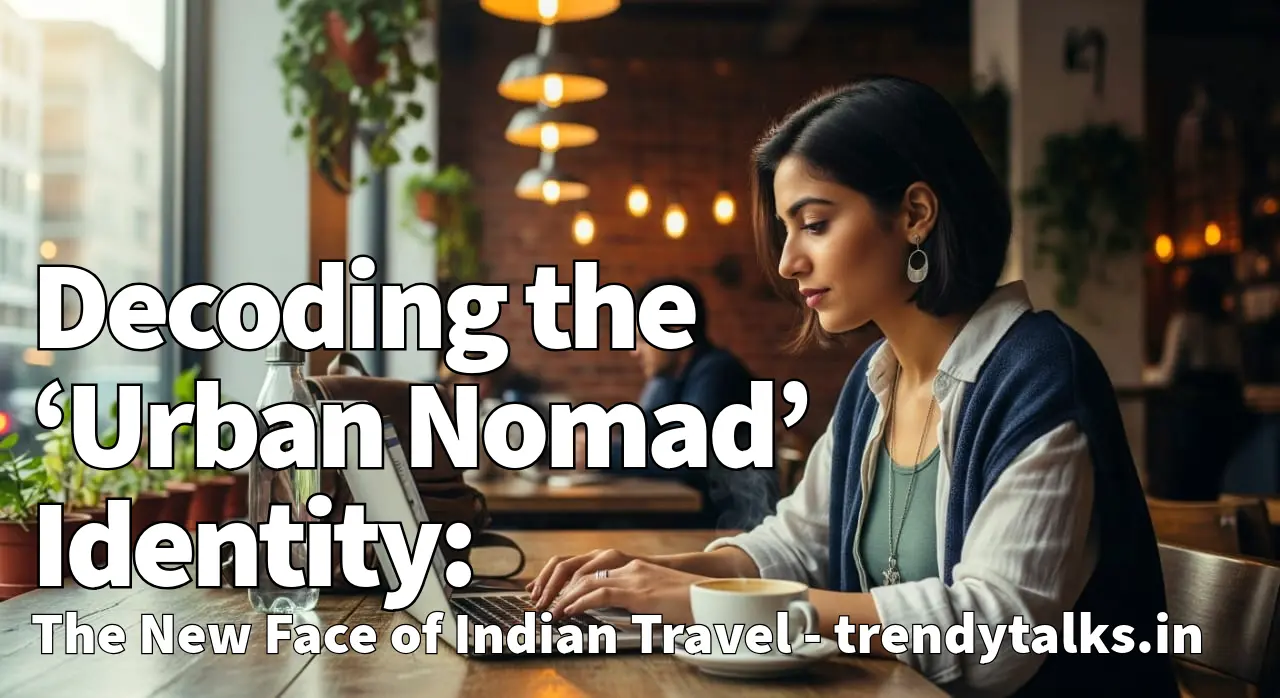The Urban Nomad lifestyle is redefining travel in India. Young professionals are blending work and wanderlust, trading office desks for cafes, co-working hubs, and mountain retreats. This rising trend reflects changing work cultures, digital connectivity, and the growing desire for freedom, flexibility, and meaningful travel experiences.

On a Monday morning in 2025, while most office-goers battle traffic in Gurgaon or Bengaluru, 27-year-old Ananya logs into her team meeting from a café in Manali. She is not on vacation. She is an urban nomad — part of a growing tribe of Indians who merge work and travel into a single lifestyle. This shift isn’t about weekend escapes anymore; it’s about a fundamental redefinition of how young Indians see themselves, their careers, and their freedom.
The Origins of the Urban Nomad in India
From Backpackers to Workation Seekers
For decades, India’s travel narrative was dominated by backpackers chasing affordability and spiritual seekers searching for meaning. But in the last five years, the profile has shifted. The urban nomad is not a traveler running away from work — but one who carries work along, seamlessly blending professional obligations with immersive travel.
Pandemic as a Turning Point
COVID-19 accelerated this transition. As offices shut, millions of professionals got a taste of remote work. For some, returning to cubicles was non-negotiable. Cities like Goa, Bir, and Rishikesh witnessed an influx of young Indians armed with laptops, choosing mountain air or beaches over polluted skylines.
Data Speaks — The Numbers Behind the Movement
Remote Work & Hybrid Models
- A NASSCOM report (2024) revealed that nearly 65% of IT and knowledge workers in India had access to hybrid or remote work models.
- The gig economy is expanding at a CAGR of 17%, projected to reach ₹455 billion by 2029, making flexible work more mainstream.
Travel Industry Response
Travel platforms like Airbnb and MakeMyTrip report a surge in “workation” searches. Co-living spaces such as Zostel, NomadGao, and Colive are designing packages explicitly for professionals, offering reliable internet, ergonomic workspaces, and community events.
Spending Power of Millennials & Gen Z
According to McKinsey India, millennials and Gen Z account for 70% of India’s discretionary spending, with travel being a top priority. Unlike earlier generations, they spend less on gold or real estate and more on experiences, including extended stays in non-metro locations.

The Impact on Indian Millennials and Gen Z
Lifestyle Shifts
The urban nomad lifestyle reflects a cultural shift — moving away from “settling down early” toward valuing experiences and mobility. A 30-year-old may now consider a year of traveling across India as valuable as an MBA, not just for personal growth but also for professional networking.
Mental Health & Productivity
There’s a double-edged sword here. While working amidst serene landscapes reduces stress and boosts creativity, inconsistent internet, lack of boundaries, and isolation can affect productivity. Mental health experts caution that without structure, nomadic living may blur the lines between work and leisure, leading to burnout.
The Sustainability Question
More travel equals more carbon footprints. However, many Indian nomads embrace slow travel — staying longer in one place, supporting local economies, and practicing sustainable living. This growing consciousness could position urban nomads as advocates for responsible tourism.
Expert Take — What Lies Ahead for India’s Urban Nomads?
Will India Introduce a Digital Nomad Visa?
Globally, countries like Portugal, Thailand, and Indonesia attract remote workers through dedicated visas. India has hinted at similar policies, especially after Kerala proposed a “Digital Nomad Village.” Experts predict experimentation with such visas by 2026.
How Tier-2 and Tier-3 Cities Could Become Hubs
The next frontier is not Goa or Himachal — but Tier-2 and Tier-3 towns. Cities like Jaipur, Coimbatore, and Mysuru offer affordability, culture, and growing digital infrastructure. With the rollout of 5G and BharatNet, even rural pockets may become viable hubs.
The Future of Hybrid Work & Travel Convergence
Industry leaders foresee a blending of tourism and work sectors. Travel companies may increasingly partner with corporations to design official workation retreats. This could redefine HR policies and corporate culture in India.
FAQ - Curious to know?
Q1: What is an urban nomad in India?
An urban nomad is a professional who combines remote work with long-term travel, choosing flexibility over a fixed office lifestyle.
Q2: Is India friendly for digital/urban nomads?
Yes. Affordable living, diverse destinations, and strong internet in urban and semi-urban hubs make India an emerging hotspot for nomads.
Q3: What are the best urban nomad destinations in India?
Popular destinations include beach-friendly Goa, tech-forward Bengaluru, culturally rich Udaipur, Jaipur, spiritual Rishikesh, and historic Pondicherry.
Q4: How does remote work fuel this lifestyle?
Remote and hybrid work models, supported by the gig economy, allow professionals to live and work from anywhere.
Q5: Will India launch a digital nomad visa?
While no official program exists yet, policymakers and states are exploring frameworks that may arrive by 2026.
The rise of India’s urban nomad signals more than a trend; it reflects a generational rewriting of work, travel, and identity. For young Indians, mobility is not just freedom — it’s the new currency of success. As policies evolve and industries adapt, the urban nomad may well become the defining face of Indian travel in the next decade. – trendytalks team



